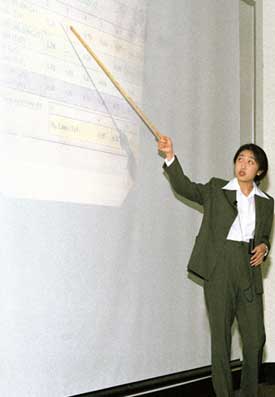 |
|
Particle Physics Made PainlessWhen nothing means something by Greg Landsberg An experimental null-result is not the end of the trail in the search for extra dimensions
The search might take you through countless
nooks and crannies, but each one that comes up
empty serves to reduce the number of nooks and
crannies remaining to look.
Physics works the same way—in fact, all of
science works the same way. If we don’t find
something in one place, that doesn’t necessarily
mean the “something” doesn’t exist. We might not
have looked in enough places. But at the same
time, we’ve scratched one more place off the list,
reducing the number of nooks and crannies that
lie ahead.
Here’s a case in point: the monojet—a single quark or gluon spotted in a
particle detector, appearing to recoil against nothing. Could the last place we
look for it turn out to be an extra dimension? A recent result from Fermilab’s
DZero detector tells us we haven’t yet reached that last place to look—
but we have trimmed the list.
Since the late 1970s, when the first proton-antiproton collider was built at
CERN, physicists have been intrigued by the idea of finding a monojet, the
simplest particle signature imaginable. On the surface, this scenario would
seem to violate the conservation of momentum, but in fact the lack of a
second object in the detector might also imply that another undetected
particle (or particles) was produced in the collision along with the jet, and
balances the momentum of the jet.
For a perfectly sealed particle detector, there is only one known type of
particle that can be missed: the neutrino, which can easily pass through
the entire Earth without a single interaction.
What if the particles produced along with the jet
are of an unknown kind—something we can’t yet
identify? Then, if we see an excess of monojet
events above the prediction from the known
physics processes, we might have a hint of new
physics beyond the Standard Model, our current
picture of the universe.
The theory of supersymmetry spurred a monojet
search as early as the 1970s. In supersymmetry,
every integer spin particle (a boson or forcecarrier)
has a semi-integer partner (a fermion)
and vice versa. In addition to doubling the total
number of fundamental particles, this theory
predicts massive neutral particles barely interacting
with other matter, which would be produced in
violent proton-antiproton collisions along with the
other ingredients in the particle soup.
Carlo Rubbia, co-winner of the 1984 Nobel Prize
with Simon Van der Meer for the discovery of the
W and Z bosons, thought he and his colleagues
had seen evidence for supersymmetry in an excess
of monojet events in the UA1 detector at CERN’s
proton-antiproton collider in the early 1980s.
However, the evidence was not confirmed by the
CERN UA2 experiment, and Rubbia’s monojets
turned out to be background from underestimated
physics processes. The monojet lost some of its
allure.
Fast forward to 1998, and enter Nima Arkani-
Hamed of UC Berkeley, Savas Dimopoulos of
Stanford, and Georgi Dvali of New York University.
These three theorists proposed that the universe
could be a much bigger place than we think. Our
three spatial dimensions could be extended to five,
or perhaps even more, by the existence of extra
dimensions that are curled up with a microscopic
radius—although that radius might be as large as
a millimeter.
Why is gravity about 1038 times weaker than the other three forces of nature?
Extra dimensions could offer a simple answer:
Gravity is just as strong as other forces, but it
appears weak to us because it propagates through
the entire space, including extra dimensions, and
thus spends only very little time in the threedimensional
world of our everyday experience,
where all other particles and forces are stuck.
This theory of extra dimensions predicted large
numbers of monojets in proton-antiproton
collisions, with the “missing” particle being a
quantum of the gravitational field, the graviton,
escaping into the extra dimensions (see Fig. 1).
Monojets regained their allure.
Both Fermilab collider detectors, CDF and DZero,
have searched for monojet signatures in the huge
amount of data recorded in Collider Run I of the
Tevatron (1992-1996). Given the UA1 experience,
it was extremely important to estimate all possible
backgrounds very carefully, distinguishing them
from an excess of monojet events that might
indicate the “echo” from extra dimensions.
The DZero team, the first
to carry out a search for
extra dimensions at a
hadron collider, reported
results on its search
for the monojets in a
June 14 seminar at
Fermilab, offered by
experimenter Hai Zheng
of Notre Dame University.
DZero physicists sifted
through 60 million protonantiproton
collisions
and identified a sample
of about 300 monojet-like
events.
The next, most important
step was to identify
possible backgrounds
and filter them out.
It turned out that one additional background, not
quite envisioned in the Standard Model, is the
signature of very energetic cosmic rays passing
through the Earth (including the DZero detector).
Muons account for most of the cosmic ray flux
reaching the surface of the Earth; very rarely,
these muons interact in the dense material of the
detector, depositing some of their energy there.
In some cases, this energy deposit looks like a
single jet, mimicking the monojet signature.
Other backgrounds include W and Z particles
recoiling against a jet, with the products of the
W or Z decay missed or mismeasured by the
detector. Careful comparison of the characteristics
of the background and expected signal events
allowed The DZero team to design special criteria,
or “cuts,” to reduce these backgrounds significantly.
As a result, the monojet sample was reduced to
some 30 events, consistent with the predicted
backgrounds (see Fig. 2).
It’s interesting to note that in string theory, the
preferred number of extra dimensions is six or
seven; any number of those can be as large as
predicted by Arkani-Hamed, Dimopoulos, and
Dvali. However, the sensitivity to extra dimensions
in the monophoton channel at the Tevatron is not
as high as at LEP, as the very recent CDF analysis
has demonstrated.
The non-observation of an excess of monojet
events is, of course, less exciting than a discovery.
However, it is an important step toward a possible
discovery in this channel. Collider Run II of the
Tevatron will increase the previously recorded data
sample by two orders of magnitude. DZero has
performed the first search for extra dimensions in
the monojet channel, resulting in stringent limits
on their size, and demonstrated that accurate
accounting for the backgrounds is possible in
this very challenging and exciting signature for
new physics.
We’re trimming the list of places to look.
On the Web: Gravity in Large Extra Dimensions
|
 When you’re searching for something, you can
usually count on finding it in the last place you look.
When you’re searching for something, you can
usually count on finding it in the last place you look.
 Since no detector is perfectly sealed, some other
processes could appear to be a monojet because
the balancing particle has escaped or eluded us.
For example, a dijet event (two quarks scattering
off each other) could look like a monojet if one
of the pair escapes detection by literally falling
through the cracks in the detector. Since dijets
are produced in proton-antiproton collisions all
the time, they might represent an important
background, even if the number of cracks is
very small and the cracks themselves are tiny.
Since no detector is perfectly sealed, some other
processes could appear to be a monojet because
the balancing particle has escaped or eluded us.
For example, a dijet event (two quarks scattering
off each other) could look like a monojet if one
of the pair escapes detection by literally falling
through the cracks in the detector. Since dijets
are produced in proton-antiproton collisions all
the time, they might represent an important
background, even if the number of cracks is
very small and the cracks themselves are tiny.
 This new hypothesis offered a possible solution
to the disturbing “hierarchy problem” of the
Standard Model:
This new hypothesis offered a possible solution
to the disturbing “hierarchy problem” of the
Standard Model: This result was used to put stringent limits on the
size of extra dimensions. For example, if there are
only two of them, they should be curled up tighter
than about 0.2 mm each. Analogous limits were
set on other numbers of extra dimensions. These
limits are comparable with, and complementary
to those obtained in the sister channel: production
of monophotons in electron-positron collisions,
recently studied at CERN’s LEP machine.
Especially for more than four extra dimensions,
the Tevatron sensitivity exceeds that at LEP.
This result was used to put stringent limits on the
size of extra dimensions. For example, if there are
only two of them, they should be curled up tighter
than about 0.2 mm each. Analogous limits were
set on other numbers of extra dimensions. These
limits are comparable with, and complementary
to those obtained in the sister channel: production
of monophotons in electron-positron collisions,
recently studied at CERN’s LEP machine.
Especially for more than four extra dimensions,
the Tevatron sensitivity exceeds that at LEP.